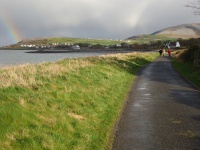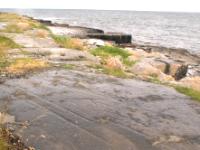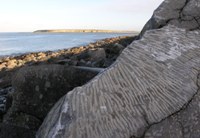Flaggy Shore – Geosite and Wild Atlantic Way Discovery Point
The Flaggy Shore is one of the most northerly parts of County stretching from the village of New Quay to Finvarra Point. Only Aughinish Island, across the narrow inlet, is further north. The low sea cliffs on Aughinish Island have formed as a result of coastal erosion. These cliffs are composed of thick layers of sediment that was deposited during the last ice age, over 12000 years ago.
Flaggy Shore is one of nine sites of geological importance that form the basis of the Burren and Cliffs of Moher Geopark. Famous for its limestone pavements, fossils embedded in the rock, including sculptured rocks along the shore called ‘Biokarst’. A paved road runs along the shore making it ideal for walkers of all ability and age. The shore itself is most beautiful but what makes the Flaggy Shore so distinctive is, the wonderful views to the west towards the Atlantic Ocean and northwards over the Galway Bay and the Connemara mountains beyond.

The Shore is an ideal place to find clues about where the ancient ice sheets came – and in what direction the glaciers moved. The clues can be be found by looking at the rocks along the shore and identifying the odd one out. Most of the cobbles and boulders along the shore are grey limestone rocks, but some are glacial erratics of other rock types, such as granite or sandstone.
Striations – Glacial Stratches

A short distance to the west of Flaggy Shore beach, we can see scratches and scrapes on the bedrock. These scratches, called striations, are all orientated WNW-ESE. When the glaciers moved over the land, they bulldozed the land’s surface. Some rocks at the base of the ice were pushed along under the moving ice sheet, whereby they scraped and scored the underlying bedrock.
The loose limestone rocks and coastal bedrock also contain various types of fossils of creatures that lived in the sea over 330 million years ago – during the Carboniferous period. The branching colonial corals (fasciculate lithostrotionids) are some of the best examples of fossils visible in these rocks.
Glacial Morraines and Coastal Cliffs

The low cliffs opposite the Flaggy Shore are on the most western headland of Aughnish Island. The cliffs are made of sands, gravels and boulders that were deposited by ice sheets during the last ice age. The ‘soft’ cliffs are slowly being eroded by the sea.
To Claim this Earthcache;
Answers "MUST BE SENT BEFORE YOU CLAIM" your find. Any claims without, will be instantly deleted. I apologise for this, however far too many cacher's seem to feel claiming is ok without answering. The whole point is to learn something about how our environment was constructed. Sadly, telepathic answers are not permitted ! Just real ones !
Please answer the following 3 questions and send these answers to me via the message centre;
1a) At the given coordinates, you will be on the shoreline. please examine the rocks here. Many have holes within them. Do you think these are Limestone or Lava?
1b) Explain in 20 words or less why you have made this decision?
2) Other than the grey coloured rocks found here, what is the next prominent colour found?
3) What is the elevation height of the beach above sea level. (Not done this before? put your GPRS on the beach and read the height, or Google Earth the coordinates)
4) Optional; Feel free to add any photos of the Shoreline you feel will either be of interest to fellow cacher's or just a memory for you. We will be delighted to view them.
Correct/Incorrect Answers; We read all replies. We endeavour to reply to all as well, however sometimes in busy periods and with huge volume of replies, it becomes difficult to reply to all. Be assured if your correct, were happy. If incorrect we will contact you and guide you towards the correct answers. The whole point is for everyone to enjoy and learn in this experience.
_______________________

|
Join us "Caching on an active Volcano" in Hawaii in July 2016
Come and be part of the EarthCache GeoVenture to the Big Island of Hawaii 13-20 July 2016. Visit caches while living in an active volcano. See lava tubes, recent lava flows and the glow of lava by night. Meet cachers from around the globe and be guided by experts. See places the tourists never see. This is one of the caching 'bucket list' trips. See here for more information.
|